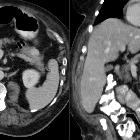glucagonoma



Glucagonomas are pancreatic endocrine tumors that secrete glucagon. Most lesions are malignant.
Epidemiology
They are very rare with an incidence of ~0.000005% or less than 1 case per 20 million. Equal incidence in middle-aged men and women.
Accounts for 1% of all the neuroendocrine tumors and less than 5% of all primary pancreatic malignancies .
Clinical presentation
Most patients present with a necrolytic migratory rash and various other elements of the 4D syndrome which includes:
- dermatitis / necrotizing migratory erythema
- diabetes mellitus
- deep vein thrombosis
- depression
Stomatitis, diarrhea, anemia, and weight loss may also occur.
Plasma level of glucagon is elevated (>500 pg/mL).
Radiographic features
Tumor size is variable, but most are large (>5 cm) and have metastasized at the time of diagnosis. Most are located in the distal pancreas and tend to demostrate significant hipervascularity.
Tumors may be solid or contain central low-attenuation areas on CT.
The MR features of this lesions have not yet been reported.
Treatment and prognosis
Standard treatment is surgical resection, depending on its location the approach can be divided into local resection, pancreactic body and tail resection and pancreatoduodenectomy.
Approximately 50% of patients survive for at least 5 years post-diagnosis.
Siehe auch:
- Insulinom
- neuroendokrine Pankreastumoren
- multiple endokrine Neoplasie Typ 1
- Whipple-Trias
- Pankreasmetastasen (Nierenzellkarzinom)
und weiter:

 Assoziationen und Differentialdiagnosen zu Glukagonom:
Assoziationen und Differentialdiagnosen zu Glukagonom:


